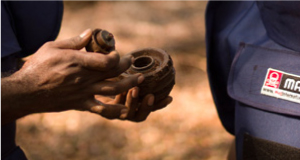Landmines
Antipersonnel landmines are explosive devices designed to injure or kill people. They can lie dormant for years and even decades under, on, or near the ground until a person or animal triggers their detonating mechanism.
They can be activated by direct pressure from above, by pressure put on a wire or filament attached to a pull switch, by a radio signal or other remote firing method, or even simply by the proximity of a person within a predetermined distance. Because no one controls the detonation of landmines, they can be referred to as victim-activated weapons. Since mines are not aimed at a specific target they can indiscriminately kill or injure civilians, including children, soldiers, peacekeepers, and aid workers.

© Sean Sutton/MAG, Sri Lanka 2013
Made of plastic, metal, or other materials, mines contain explosives and some contain pieces of shrapnel. A landmine blast can be fatal or cause injuries such as blindness, burns, damaged limbs, and shrapnel wounds. Stepping on a blast antipersonnel mine will invariably cause foot and leg injuries, and secondary infections usually resulting in amputation. Fragmentation mines project hundreds of metal fragments, which cause the victim to suffer deep wounds. Bounding fragmentation mines spring up approximately one meter and then explode, firing metal fragments throughout a large radius.
Article 2.1 of the Mine Ban Treaty defines an antipersonnel mine as: “a mine designed to be exploded by the presence, proximity or contact of a person and that will incapacitate, injure or kill one or more persons.” This means that the treaty bans the use of mines which are victim-activated, while the use of some mines in “command-detonated” mode (meaning operated by remote control) is allowed under the treaty.
Antivehicle mines, also called antitank mines, are designed to destroy or disable vehicles. They contain more explosives than antipersonnel mines and often require more pressure or weight on top of them to detonate. Antipersonnel mines are banned under the Mine Ban Treaty but antivehicle mines (unless they have sensitive fuzes and function like antipersonnel mines) are not.
In recent years, greater attention has been paid to the extensive use of improvised mines, primarily by non-state armed groups. These improvised landmines are often referred to as improvised explosive devices (IEDs) or booby-traps. However, most are exploded by the presence, proximity, or contact of a person and therefore meet the definition of an antipersonnel mine contained in the Mine Ban Treaty and are prohibited regardless of whether they were fabricated in a factory or elsewhere.
As of January 2021, 55 states and five other areas have an identified threat of antipersonnel mine contamination. There is no credible estimate of the total number of mines in the ground worldwide, however the impact of mines can be measured in several ways, including totaling the amount of land that is unusable due to contamination or gathering data about the number of people killed or injured by mines.
(Last updated January 2021)




